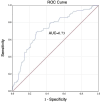Prognostic Nutritional Index is A Useful Predictive Marker for Morbidity and Mortality in Surgery for Perforated Peptic Ulcer
- PMID: 40831514
- PMCID: PMC12360380
- DOI: 10.2147/JIR.S519037
Prognostic Nutritional Index is A Useful Predictive Marker for Morbidity and Mortality in Surgery for Perforated Peptic Ulcer
Abstract
Background: Prognostic Nutritional Index (PNI) is a useful predictor of outcomes in surgical patients. Emergency surgery for perforated peptic ulcer (PPU) remains associated with high morbidity and mortality. However, the relationship between PNI and outcomes after PPU surgery has not been fully explored. This study aimed to assess the performance of PNI in predicting morbidity and mortality among patients undergoing surgery for PPU.
Methods: This retrospective study included patients who underwent emergency surgery for PPU between 2018 and 2023. Multivariate analyses were performed to identify risk factors associated with postoperative morbidity and mortality. The predictive performance of PNI was evaluated using the area under the receiver operating characteristic curve.
Results: A total of 320 patients were included. The overall morbidity and mortality rates were 26.6% and 17.8%, respectively. The PNI was significantly lower in patients who experienced morbidity or mortality. Multivariate analysis showed that a low PNI was an independent predictor of both morbidity (Odds Ratio [OR], 1.05 per-point decrease; 95% Confidence Interval [CI], 1.01-1.10; P = 0.02) and mortality (OR, 1.09 per-point decrease; 95% CI, 1.02-1.16; P = 0.01). Patients were categorized into three PNI groups: normal (PNI ≥ 50, n = 78), mildly low (PNI 45-50, n = 61), and severely low (PNI < 45, n = 181). Mortality and morbidity rates significantly differed across these groups: 1.3%, 7.4%, and 28.7% for mortality, and 10.3%, 16.4%, and 37% for morbidity, respectively (P < 0.001). The area under the curves (AUC) for PNI predicting morbidity and mortality were 0.73 (95% CI, 0.67-0.79) and 0.81 (95% CI, 0.76-0.86), respectively.
Conclusion: PNI is a reliable predictor of morbidity and mortality following surgery for PPU. A PNI-guided risk assessment could be useful for the perioperative management of PPU patients.
Keywords: morbidity; mortality; perforated peptic ulcer; prognostic nutritional index; surgery.
© 2025 Jia and Li.
Conflict of interest statement
The authors report no conflicts of interest.
Figures
Similar articles
-
Prognostic nutritional index as a potential predictor of prognosis in patients with sepsis: a retrospective cohort study.Front Nutr. 2025 Jul 1;12:1600943. doi: 10.3389/fnut.2025.1600943. eCollection 2025. Front Nutr. 2025. PMID: 40667438 Free PMC article.
-
Comparison of Two Modern Survival Prediction Tools, SORG-MLA and METSSS, in Patients With Symptomatic Long-bone Metastases Who Underwent Local Treatment With Surgery Followed by Radiotherapy and With Radiotherapy Alone.Clin Orthop Relat Res. 2024 Dec 1;482(12):2193-2208. doi: 10.1097/CORR.0000000000003185. Epub 2024 Jul 23. Clin Orthop Relat Res. 2024. PMID: 39051924
-
[Volume and health outcomes: evidence from systematic reviews and from evaluation of Italian hospital data].Epidemiol Prev. 2013 Mar-Jun;37(2-3 Suppl 2):1-100. Epidemiol Prev. 2013. PMID: 23851286 Italian.
-
Age differences in the association of prognostic nutritional index quartiles and heart failure in US adults: the NHANES 2011-2018.Front Nutr. 2025 Jun 24;12:1533632. doi: 10.3389/fnut.2025.1533632. eCollection 2025. Front Nutr. 2025. PMID: 40630165 Free PMC article.
-
Ultra-radical (extensive) surgery versus standard surgery for the primary cytoreduction of advanced epithelial ovarian cancer.Cochrane Database Syst Rev. 2022 Aug 30;8(8):CD007697. doi: 10.1002/14651858.CD007697.pub3. Cochrane Database Syst Rev. 2022. PMID: 36041232 Free PMC article.
References
LinkOut - more resources
Full Text Sources



